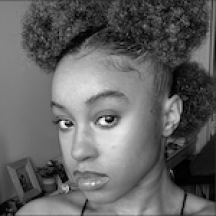Sensually sewn into this editorial of cinematic stills, captured by Adaeze Okaro, is her vibrant and globally recognisable West African culture. It is strategically presented at the forefront of this narrative, which is one of "love, identity, and beauty". A narrative that is personal to Okaro and serves as a time capsule, placing us in the perspective of her as her childlike self, seeing her parents style their West African attire complete with accessories, proudly displaying bright colours, intricate textures and bold recurring patterns.
As we come to understand how Okaro's model Kyeermun Milaham Nantok embodies elements of her parents' being, the way in which she is captured effortlessly makes all the more sense. Okaro captures both work and play with juxtapositions of glamour and self preservation, and while the theme of relaxation becomes louder, in contrast the images are extremely peaceful as a parent would hope to be after a long day at work, or on a weekend preparing for the following week ahead. Some of the poses captured are so candid they could be mistaken for the work of a documentary photographer, as in one scene Nantok lounges in a comfortable crisp white vest and underpants set on a bedspread with rows of yellow and black contrasting print. She submits to relaxation and rests her wig on the bed along with her, while in others we can almost feel the weight of her body sinking into the furniture.
© ADAEZE OKARO
Each photograph I create is a tribute to those quiet Sunday mornings...meticulous rituals of my parents became the seeds from which my artistic journey blossomed. Like my mother adorning herself & choosing a "Gele" or a lipstick shade to complement her lace attire...my father's deliberate selection of colors for his traditional attire, a tie or suit jacket for a Monday morning. I learned the language of aesthetics and the poetry embedded in personal adornment.
Like many photographers, Okaro's responsibility to turn her mind's vision into a visual for an audience extends far beyond clicking the shutter button. For Solace, she is the stylist, makeup artist, set producer and more, and seamlessly as a set producer, Okaro ties her experience of patterned West African fabrics from her childhood into each image via her selection and placement of fabrics on set. Everything captured in shot is intentional whilst appearing effortless and candid. In another scene where her model basks in a romantic floor length pink gown, the walls, and possibly windows to block out light, are draped with sheets boasting repetitive floral designs giving a wallpaper or curtain-like effect. The sheets blur into the background as Okaro uses a wide aperture, which also compensates for her dimly lit high contrast scene. She is able to capture fine details with just enough light whilst preserving the dark yet tranquil mood. She selectively brings forward anything but the background with her range of focus and the floral drapes do not detract from her model but complement the scene and particularly marry well with her deep rose coloured makeup.
© ADAEZE OKARO
Fabric and textile designs are intriguingly diverse across Africa, and in West Africa alone there are 17 countries that fall within the region: Gambia, Ghana and Nigeria to name just a few. With each country having one or more design uniquely associated or popular with the people of that region, the techniques used to create attention grabbing, geometric and repetitive patterns vary. From Tie-dyeing to wax printing and weaving there are many designs that can be created and tailored for everyday wear. Some of the designs hold special meaning and tell stories passed down through generations, while others portray political standpoints, or are used for ceremonial dress and celebrations like weddings.
In this dance of fabrics, beads, and vintage shoes, I become not only the photographer but the storyteller...As I stand behind the lens, I find myself not just capturing images but curating moments that mirror the timeless elegance of those childhood scenes. The warm light pouring through the windows in one of my many universes mirrors the eastern sun my father walked into, creating a seamless connection between past and present.
© ADAEZE OKARO
Okaro so cleverly encapsulates the sought after vintage look and feel in this alluring string of images, which is popular across many forms of media, arts and culture, from photography and fashion, to music and television. She aims for a cinematic appeal which is enhanced through the colour grading of her images, where tints of colour are added to the shadows and the darkest points are reduced further. Like an adept seamstress, Okaro meshes the essence of vintage into this editorial with the experience of nostalgia - a memory wrapped in the feeling of familiarity. Nostalgia can evoke a sense of comfort as it transports us all the way back to our earliest childhood memories, which coincides with the title, Solace, as well as Okaro's original intent with this project.
Often, nostalgia is used as a tool within arts and culture and has the power to feel like a perfectly replicated experience whilst simultaneously leaving room for exploration, discovery and or rediscovery. If used effectively, it can serve as a pawn to be remixed, putting a new spin on something old, seen or done before, so that it can be repackaged and experienced again by those who are familiar with its origins, or for the first time by new, unfamiliar audiences. The balance of the two elements can also be key to reaching a wider audience, but this also opens up a larger platform for critique - Is it possible to please the two sides at once? - And here, in this silently stunning editorial, Okaro serves us her own nostalgia on a silver platter, sharing her West African culture romantically with all who are familiar and unfamiliar in a room that whether it's warm or cool, it's equally as inviting.















